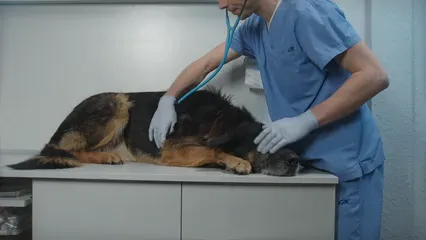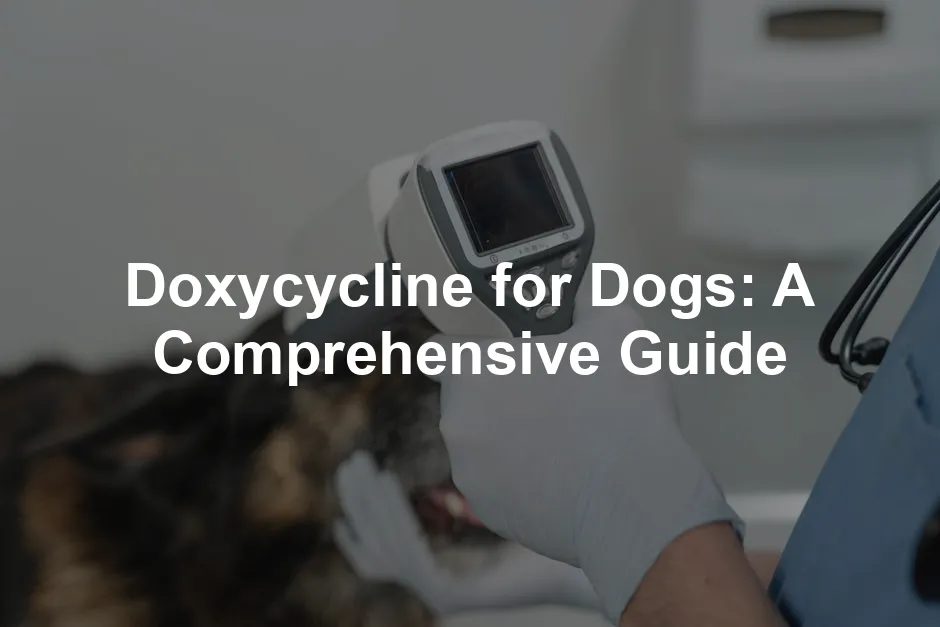Introduction
Doxycycline is a widely prescribed antibiotic for dogs. It effectively treats various bacterial infections. Understanding its uses, side effects, and proper administration is crucial for pet owners.
Speaking of pet care, having a Dog First Aid Kit on hand can be a lifesaver. Accidents happen, and being prepared with essentials can help you tackle emergencies effectively!
Summary and Overview
Doxycycline belongs to the tetracycline class of antibiotics. It works by inhibiting protein synthesis in bacteria. This makes it significant in veterinary medicine, as it combats a wide range of infections.
Doxycycline treats conditions such as Lyme disease, respiratory infections, and urinary tract infections. It’s essential to consult your veterinarian for appropriate dosage and administration guidelines. This helps prevent complications and ensures effective treatment. Also, being aware of potential side effects and drug interactions is vital for your dog’s health.

For more information on Lyme disease in dogs, you can read this detailed guide lyme disease in dogs.
What Is Doxycycline?
Overview of Doxycycline
Doxycycline is a tetracycline antibiotic. It targets bacteria by inhibiting protein synthesis, which is necessary for their growth. This broad-spectrum antibiotic is effective against many types of gram-positive and gram-negative bacteria.
By stopping bacteria from producing proteins, doxycycline helps your dog’s immune system fight off infections. This makes it a valuable tool in treating various bacterial diseases in dogs.
Brand Names and Forms
Doxycycline is available under several brand names. Common ones include Vibramycin, Doryx, Monodox, and Oracea. Each brand may come in different formulations.
You can find doxycycline in various forms: tablets, capsules, liquid, and gel. Tablets and capsules are meant for oral ingestion, while the liquid form is useful for easier administration. The gel form is specifically used to treat periodontal disease in dogs.
It’s important to note that while doxycycline is FDA-approved for human use, its application in veterinary medicine is often off-label. The gel form is the only FDA-approved version specifically for dogs.

Uses of Doxycycline for Dogs
Common Conditions Treated
Doxycycline is effective for treating various bacterial infections in dogs. Here are some common conditions:
- Tick-borne diseases: These include Lyme disease and Rocky Mountain spotted fever.
- Respiratory infections: Doxycycline helps combat infections affecting the lungs.
- Urinary tract infections: It effectively addresses bacterial causes of UTIs.
- Heartworm disease: Doxycycline is part of the treatment protocol for heartworm infections.
- Periodontal disease: This antibiotic is used to manage gum infections.
Additionally, doxycycline can be used off-label to prevent secondary infections, especially after viral illnesses.

While we’re at it, don’t forget to keep your furry friend hydrated! A Dog Water Dispenser can help ensure they always have fresh water available. Hydration is key to keeping them healthy!
Efficacy and Expected Outcomes
Doxycycline acts quickly, with effects noticeable within one to two hours. However, significant improvement in your dog’s symptoms may take a few days. It’s essential to follow the prescribed course completely.
Failing to do so can lead to antibiotic resistance, making future infections harder to treat. Always stick to your veterinarian’s instructions for the best results.

Dosage of Doxycycline for Dogs
Recommended Dosages
When it comes to dosing doxycycline for dogs, the general recommendation is between 5 to 10 mg per kilogram of body weight. This dosage can vary based on the condition being treated. For acute infections, a higher dose may be necessary, while chronic infections typically require a lower dose over a longer period. Always consult your veterinarian for the most accurate dosage tailored to your dog’s specific needs.

Administration Guidelines
Administering doxycycline can be straightforward, but there are some important tips to keep in mind. It’s best to give it with food to reduce potential stomach upset. However, avoid giving it alongside dairy products or iron supplements, as these can hinder the medication’s effectiveness.
Another crucial point is ensuring your dog has adequate water intake. This helps prevent esophageal irritation, which is a risk when the medication is given without enough liquid. Lastly, never adjust the dosage without consulting your veterinarian first. They can provide the best guidance for your dog’s condition.

And speaking of proper care, have you considered investing in a Pet Thermometer? It’s a handy tool to monitor your dog’s health, especially if they seem under the weather!
Side Effects of Doxycycline for Dogs
Common Side Effects
Most dogs tolerate doxycycline well, but some mild side effects can occur. These include nausea, vomiting, and diarrhea. If your dog experiences gastrointestinal upset, administering doxycycline with food can help mitigate these issues. Monitor your dog closely during treatment, and if side effects persist or worsen, reach out to your veterinarian for advice.
It’s essential to be aware of these potential reactions to ensure your dog’s health and comfort while undergoing treatment. Understanding the side effects can help you respond quickly and effectively.

Serious Side Effects
Doxycycline is generally safe, but severe side effects can occur. Liver issues are one of the most concerning risks. Elevated liver enzymes may indicate potential liver damage. If you notice yellowing of your dog’s skin or eyes, seek veterinary help immediately.
Allergic reactions are another serious concern. Symptoms can include swelling, difficulty breathing, or hives. Always monitor your dog closely during treatment. If you see any unusual behavior or symptoms, contact your vet right away. Early detection of these issues can make a significant difference in your dog’s health.

Doxycycline Drug Interactions
Medications to Avoid
Doxycycline can interact with several common medications. Antacids containing aluminum, calcium, or magnesium can reduce its effectiveness. Iron supplements also pose a risk, as they can hinder absorption. Avoid giving these medications within a few hours of doxycycline.
Other drugs to be cautious of include anticoagulants like warfarin, which may require dosage adjustments. Additionally, avoid using doxycycline with certain antibiotics, such as penicillin or cephalosporins. Always discuss your dog’s current medications with your veterinarian to prevent complications.

Importance of Veterinary Consultation
It’s crucial to inform your veterinarian about all medications your dog is taking. This includes over-the-counter drugs, supplements, and any prescription medications. Your vet can help manage potential interactions effectively. They may suggest adjusting dosages or timing to ensure safety. Regular check-ins can also help monitor your dog’s response to treatment.

Special Considerations
Precautions for Specific Populations
Doxycycline should be used with caution in pregnant or nursing dogs. It can affect the development of puppies, leading to potential tooth and bone issues. Young dogs are also at risk, as their bones and teeth are still developing. Consult your veterinarian if your dog falls into these categories.

Storage and Handling
Proper storage of doxycycline is crucial for maintaining its effectiveness. Keep doxycycline in a tightly sealed container, away from light and moisture. Exposure to these elements can degrade the medication, diminishing its potency.
It’s essential to store it at room temperature, typically between 68°F and 77°F. Liquid formulations, if prescribed, should also be kept at room temperature and discarded after 14 days unless directed otherwise by your veterinarian.
Always keep doxycycline out of reach of children and pets. Accidental ingestion can lead to serious side effects. It’s better to be safe than sorry, so ensure these medications are stored in a secure place.

Speaking of safety, consider getting a Dog Collar with ID Tag. It’s an easy way to keep your pup safe should they go adventuring without you!
Conclusion
In summary, doxycycline is a valuable antibiotic for treating various bacterial infections in dogs. Following your veterinarian’s advice is crucial for safe and effective treatment. This ensures your dog receives the right dosage and minimizes potential side effects.
Stay vigilant about your dog’s health. If you notice any adverse effects or unusual behavior, contact your veterinarian immediately. Early intervention is key to maintaining your pet’s well-being.

And while you’re at it, don’t forget to reward your furry friend with some tasty Dog Treats! After all, they deserve a little pampering for being such good boys and girls.
FAQs
What is doxycycline used for in dogs?
Doxycycline treats various infections, including tick-borne diseases, respiratory infections, and urinary tract infections.
How should doxycycline be administered to dogs?
Administer the medication with food to reduce stomach upset. Always follow your vet’s instructions for dosage and timing.
What should I do if I miss a dose of doxycycline for my dog?
If you miss a dose, give it as soon as you remember. If it’s close to the next dose, skip it. Never double up on doses.
Can doxycycline cause side effects in dogs?
Yes, side effects may include nausea, vomiting, and diarrhea. Contact your vet if you notice severe reactions.
Is it safe to give human doxycycline to dogs?
Human formulations may not be safe. Always use veterinary-prescribed doxycycline to avoid potential risks.
How long does it take for doxycycline to work in dogs?
Doxycycline usually starts working within one to two hours, but visible improvements may take a few days.
What are the signs of a doxycycline overdose in dogs?
Overdose symptoms can include vomiting, diarrhea, and lethargy. Seek veterinary care immediately if you suspect an overdose.
Please let us know what you think about our content by leaving a comment down below!
Thank you for reading till here 🙂
All images from Pexels





